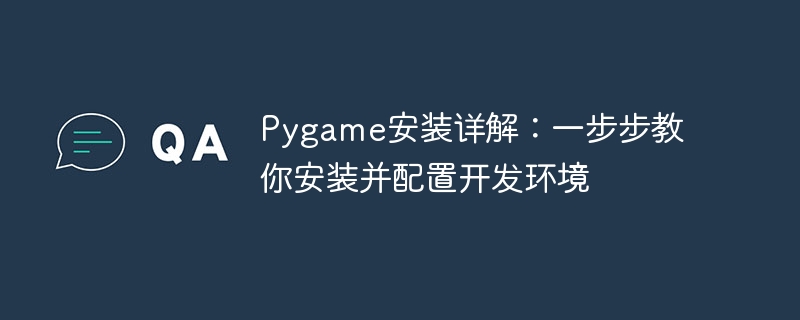Home >Backend Development >Python Tutorial >Pygame installation details: teach you step by step to install and configure the development environment
Pygame installation details: teach you step by step to install and configure the development environment
- PHPzOriginal
- 2024-02-20 16:54:04793browse

Pygame installation details: teach you step by step to install and configure the development environment, specific code examples are required
Introduction:
Pygame is a game development library based on Python , which provides a wealth of tools and functions to make game development simple and fun. This article will introduce in detail how to install Pygame, configure the development environment, and provide specific code examples.
Part One: Install Pygame
- Installing Python:
Before you start installing Pygame, you first need to make sure that Python is installed on your computer. You can download the Python version suitable for your operating system from the official Python website (https://www.python.org/) and install it according to the installation wizard. -
Install Pygame:
After installing Python, we need to install the Pygame library. Open a terminal (Windows users can open it in the command prompt) and enter the following command to install Pygame:pip install pygame
This command will automatically download and install Pygame from the Python package index.
Part 2: Configure the development environment
- Create the project folder:
Create one in the directory where you want to store your Pygame project A new folder to store your code and resource files. -
Create a game window:
In the project folder, create a new Python file and enter the following code in the file:import pygame # 初始化Pygame pygame.init() # 设置窗口大小 screen_width = 800 screen_height = 600 screen = pygame.display.set_mode((screen_width, screen_height)) pygame.display.set_caption("My Game") # 游戏主循环 running = True while running: for event in pygame.event.get(): if event.type == pygame.QUIT: running = False # 渲染代码 pygame.display.update() # 关闭Pygame pygame.quit()This code creates a game window and set the window size and title. The main loop of the game window constantly listens for events and updates the rendering.
-
Run the game:
After saving the file, enter the project folder in the terminal and run the following command:python 文件名.py
Where the file name.py is your The name of the Python file created. After executing this command, you will see a blank game window.
Part 3: Game Development with Pygame
-
Add a background image:
Create a file named assets in the project folder folder, place your background image file in that folder. Add the following code in the rendering code section of the game's main loop:# 加载背景图像 background = pygame.image.load("assets/background.jpg") # 渲染背景图像 screen.blit(background, (0, 0))This code loads the background image and renders it onto the window.
-
Add game character:
Place the image file of the game character in the assets folder, and add the following code in the rendering code section of the game's main loop:# 加载游戏角色图像 player_img = pygame.image.load("assets/player.png") # 渲染游戏角色图像 screen.blit(player_img, (x, y))This code loads the image of the game character and renders it onto the window, where x and y are the horizontal and vertical coordinates of the game character respectively.
-
Response to user input:
Add the following code in the event listening code section of the game's main loop:# 响应用户输入 keys = pygame.key.get_pressed() if keys[pygame.K_LEFT]: x -= 1 if keys[pygame.K_RIGHT]: x += 1 if keys[pygame.K_UP]: y -= 1 if keys[pygame.K_DOWN]: y += 1
This code detects whether the user presses a certain key, and updates the game character's coordinates based on user input.
Summary:
Through the introduction of this article, we learned how to install Pygame and configure the development environment. At the same time, we also learned some basic Pygame code examples, including creating game windows, loading images and rendering, responding to user input, etc. I hope this article can be helpful to beginners in Pygame development, and also encourages everyone to further explore and develop their own game projects.
The above is the detailed content of Pygame installation details: teach you step by step to install and configure the development environment. For more information, please follow other related articles on the PHP Chinese website!

